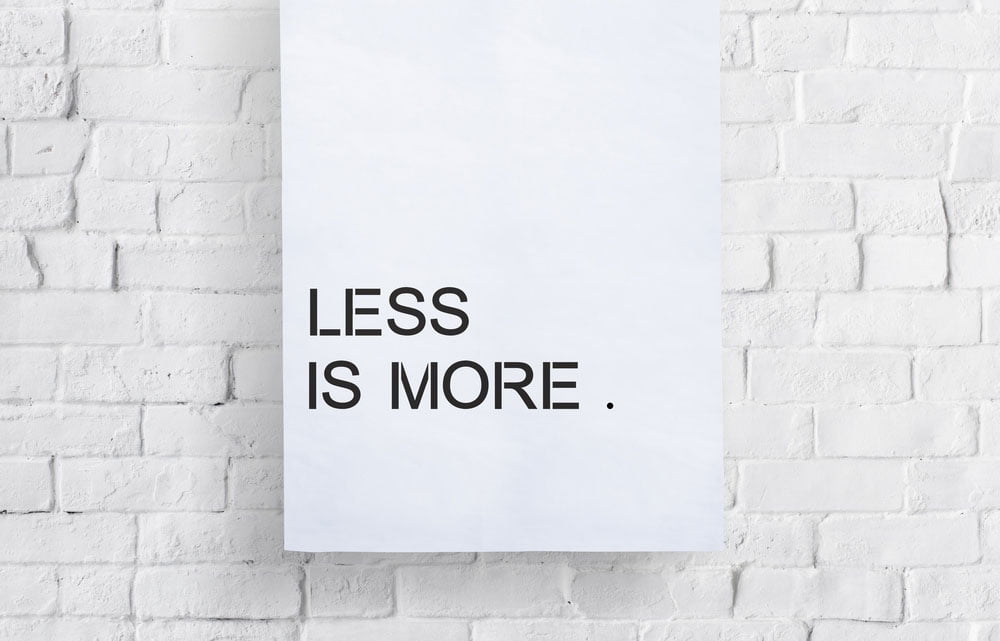When it Comes to Presentations – Less is More


Michael Sinnhuber is an experienced presentation designer, speaker and entrepreneur. We’re proud to have him as a part of our team at Presentation-Guru.com. He travels the world helping great businesses to stand out from their competitive crowd by making them think more clearly about some fundamental principles of communication and design. This a great article for all presentation designers, coaches and presenters to ask themselves just how well they understand the whole ‘Less is More’ concept.
But what is this ‘LESS’ and how can I find the ‘less’ in my topic?
A business event – two weeks ago. Awesome location, interesting topics and… a firework of bullet points. A speaker steps on the stage and starts his personal firework. Five minutes later, 99% of the audience members are playing around on their smartphones to escape the “death by powerpoint”. But the guy keeps on firing his bullets for another 30 minutes. Does that sound familiar to you? I am sure it does.
In the lunch break I find myself seated just next to him. After a little small talk he asks me “What do you do for a living?”. “I save the world from boring presentations”, I tell him. “Oh, that sounds like a ‘Mission Impossible’” he says with a giggle. “When I think of all the boring presentations I see every day, I could fall asleep immediately. But I know, that less is more”, he adds.
9 out of 10 times when I tell people what I am doing, I get the exact same answer. So it seems, that everybody knows the simple basic rule of a great presentation, right? But if everybody knows it, why the hell are 95 % of presentations out there are so bad?
Knowledge is nothing without execution
In my opinion the answer is quite simple. “Knowing” and “saying” are easy tasks, but “doing” is something completely different. Because it requires hard work.
This is true for any topic in our life, right? I guess everybody in the so called “modern world” knows that we shouldn’t eat too much fatty food and work out on a regular basis to stay healthy. But the truth is different – we are getting fatter and fatter. Why? Because working out is hard work.
And, no matter if we are talking about health or presentations, too many people simply don’t want to put in that hard work or do not have the time to.
When preparing a presentation, we think everything we have to say is important and people have to hear as many of it as possible in a given time. That’s why we copy/paste tons of text onto PowerPoint slides and hope, that if we hammer out enough info, the message will find its way to the audience anyway. But – as sad as it is – it doesn’t!
And by the way, if this was the way it worked, the proverb would be “more is more”, but it says “less is more”. So why is it less and what is this “less” in your topic?
Do you remember?
Think about all the presentations, speeches and conferences you attended in last couple of months. How many great presentations come to your mind immediately? One? Two? Three? None? If you remember any of them, what exactly do you remember? Is it the presenter, the topic, a message? When you are like 90% of the people, chances are, you don’t remember a lot.
Why am I asking these questions? To make clear that, compared to the tons of information we hear and see every day, only a tiny fraction of it makes it to our longterm memory. Less information is being remembered and it gets harder and harder for any message to survive the fight for attention.
Be memorable
Having said that, it seems quite obvious, that if you present, your audience will also remember only a tiny fraction of what you are saying, right? Sad but true.
How can you make sure, that people remember the right part of it or anything at all? Well, YOU have to define, what people should take away from your speech! That’s why it’s often called “take away message” or core message. Think of it like a bag, you are giving away to your audience, when they leave the room. You define what’s in the bag – but it can only be ONE thing.
What’s your message?
So, if you want to be memorable, you have to define your core message first. To find it, strip your content down to the bare essentials. What is the main argument and why should your audience care? Put yourself in the shoes of your audience and answer their number one question, being “what’s in it for me”.
You find it hard to define your core message? Just think of a first aid course. A typical first aid course takes between 16 and 30 hours to complete. In all that time a lot of important information is delivered to the audience. Important information that can save lives.
After finishing the course, you walk out and hope, that you will never have to use anything you’ve learned. And, a lot of it will be forgotten pretty soon. But, there’s that one core message, that you should never ever forget, no matter if it’s 2 months or 20 years after completing the course.
And that is “HELP”! Do anything! Don’t walk by an accident, help! No matter, if you call the ambulance or you administer first aid, do anything possible to help the victims! So, when defining your core message, always think of what’s the “HELP” of your topic.
Will this be easy? No! Worth it? Absolutely! Because the payoff is pretty obvious. If you don’t know your core message, how should any audience on earth get it? But if you define a great take away message, you have the chance to stay in the mind of your audience forever.
Creating a memorable presentation
Once you have found your message, build a story around it. Why a story? Stories are easier to remember than plain information chunks. I know that storytelling is one of the most misused buzzwords in today’s marketing. But it works, just think of your childhood. I am sure you remember the core message of all the fairy tales. But none of them was ever presented to you in list of bullet points, right?
Telling a story is not rocket science. Just put yourself in the shoes of your clients and think of the challenges and issues they might have? How can your products or services solve those issues?
Think through all the steps, use real characters and let them experience the whole situation from suffering to solving the issue. Done right, your core message will be remembered as the problem solver forever and always. Less information with more value.
Conclusion
We live in world of massive information overflow. The more information we hear and see every day, the less we can remember.
If you want to stand out with your presentation and be memorable, you need to find the core message of your topic and define it as the take-away message for your audience to remember.
Done right, this kind of less information with more value will lead to more success – giving “Less is more” a meaning.














Dave Mac
29th August 2016 at 11:26 pm
Great article. Perhaps the best quote is ever read about slide design: “KNOWLEDGE IS NOTHING WITHOUT EXECUTION”. Everyone’s taken a presentation design course, or read Presentation Zen, or watched a Jobs’ keynote, but they still can’t get away from their crazy bullet points. I think it comes down to 2 things:
1. They get started “zenning” their slides and feel that this is not something they can do, they just can’t get it to the same standard
2. They realize it takes work to plan this out and design good slides. At first glance everyone thinks it will be easy, until they actually have to work at it
Cheers,
Dave
Michael
30th August 2016 at 12:07 pm
Absolutely Dave, I fully agree! Thanks for taking the time commenting – glad you like the article!